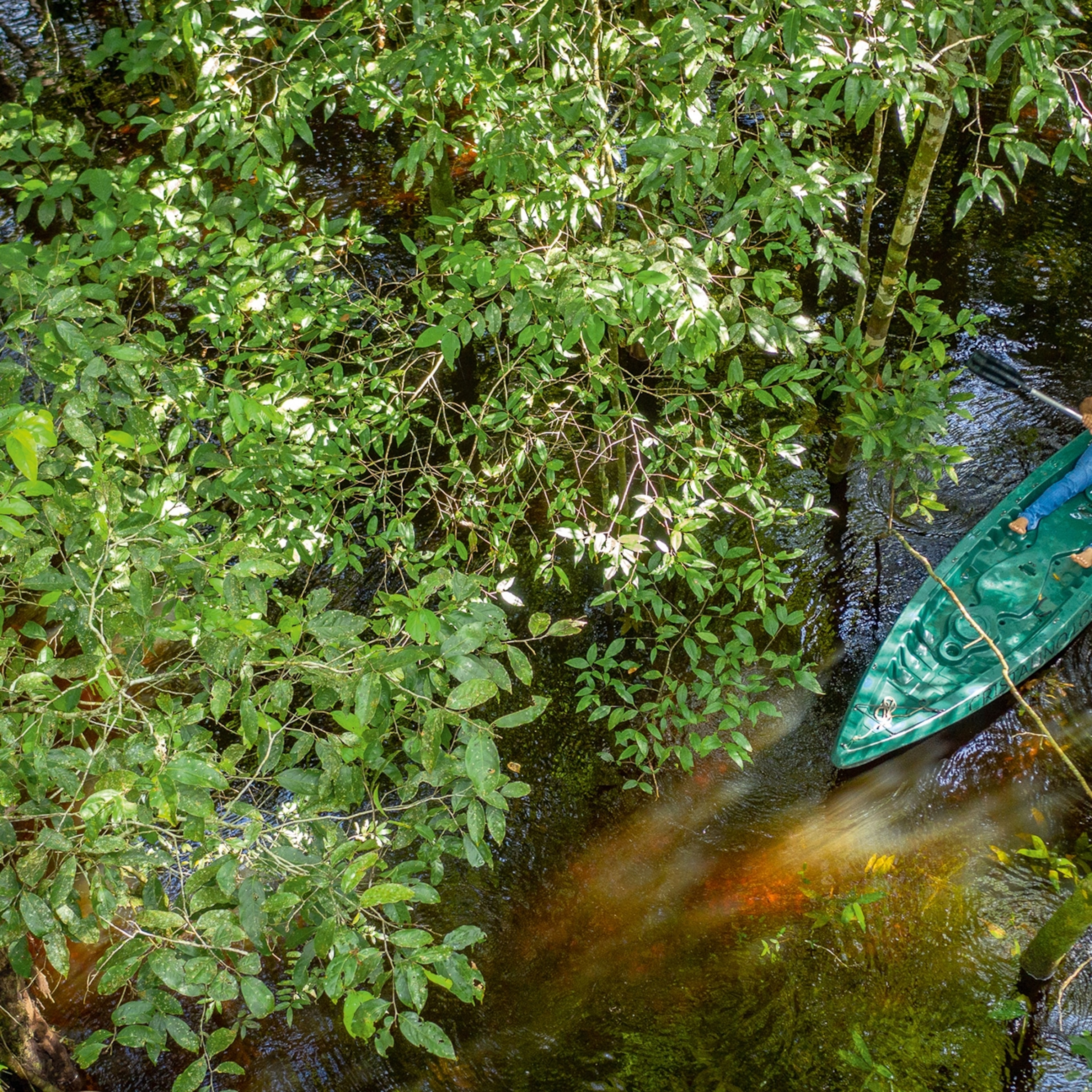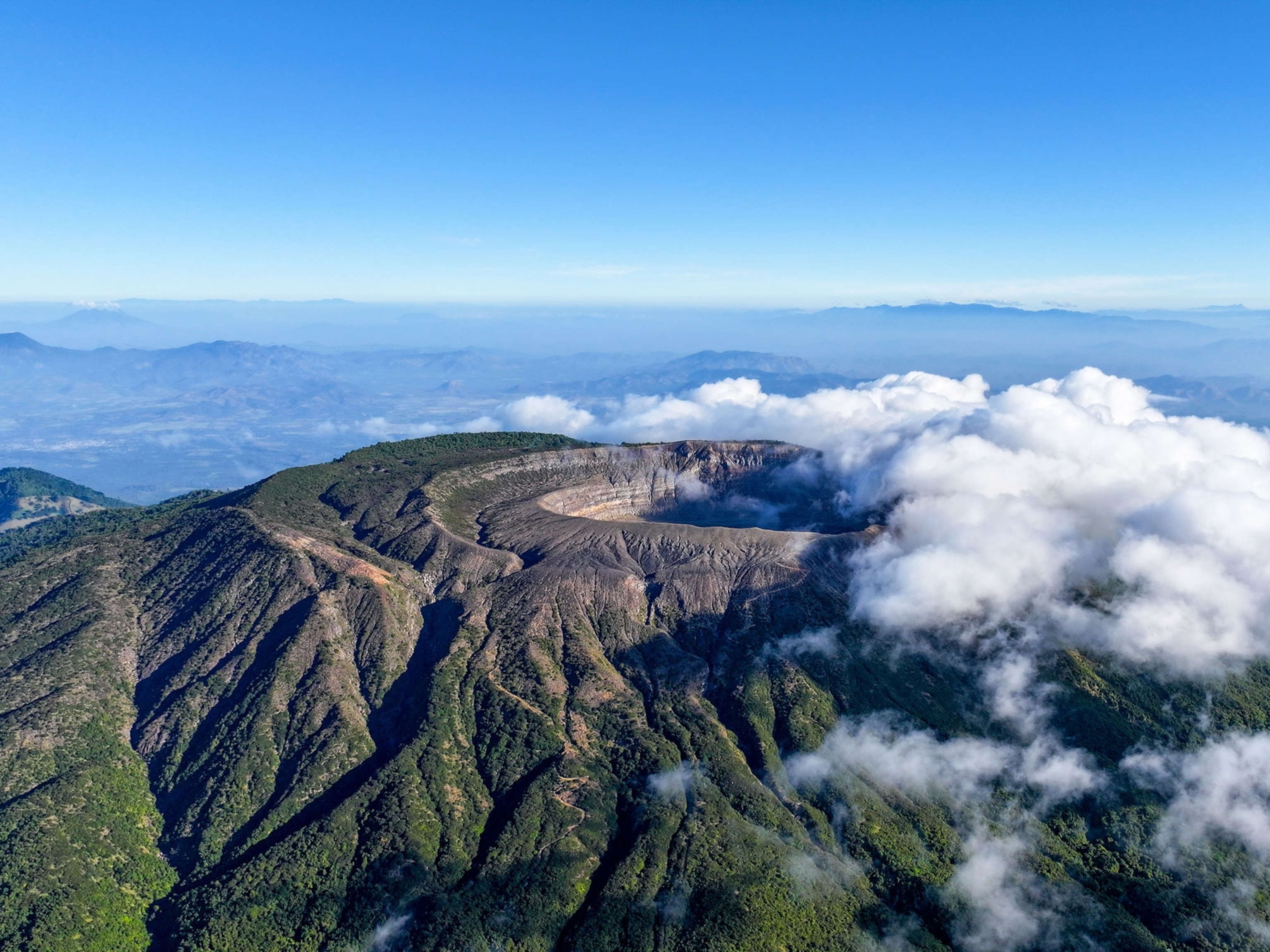Exploratory Kayakers Ben Stookesberry, Benny Marr, Chris Korbulic, Pedro Oliva
Four kayakers make a source-to-sea first descent of one of the most remote and treacherous rivers on the planet, tucked away in the jungles of New Britain in Papua New Guinea.
Ben Stookesberry, Chris Korbulic, and Benny Marr crowded in next to their stack of kayaks in a tiny cave partway up one side of a near-vertical gorge, 5,000 feet tall in places—and stared at the frayed end of a rope. They had just attached the rope to the back of their teammate Pedro Oliva’s kayak and lowered him, in his boat, past the last 80 feet of overhanging rock and into the stretch of uncharted, Class V white water—the most difficult class of passable rapids—below. Either the rope had broken, or Oliva had cut it. The kayakers couldn't see down to the river. The evening light had begun to fade, and it had started to rain, which meant that the water level in the narrow gorge would rise quickly and make the rapids even more dangerous.
Seven days earlier, a helicopter had deposited the four professional kayakers at the top of a 30-mile stretch of the Beriman River, one of the most remote and unforgiving rivers on the planet, located on the island of New Britain in Papua New Guinea. Once the team steered their boats into the current—with water neon blue from the minerals in the artesian groundwater that feeds the river—they knew they could not go back the way they came.
“The level of commitment was pretty spectacular,” says Korbulic. “In a lot of the places, there would have been nothing that somebody outside the canyon would have been able to do. Once you're inside, you can't get out other than by going down the river.”
It turned out that the rope had gotten stuck on the back of Oliva’s kayak. Fortunately, Oliva, a Brazilian father of three, had a boat just short enough that when he leaned all the way back, he was able to cut the cord and paddle the next series of rapids.
It took the team 13 days in total to run eight of the river’s 13 gorges, including seven days of brutal portages (or carrying their boats) around the other five, before eventually floating into the Solomon Sea on June 21, having descended over 3,000 vertical feet over 30 miles.
People don’t usually go to Papua New Guinea to kayak. The country boasts more than 800 live native languages, and its roads don’t always connect one side of an island to the other. Only 20 percent of the population lives with modern amenities, and many live in tribes in the mountains with few or no facilities, no monetized economy, and little contact with other tribes or the outside world. Locals have to keep a constant watch on 16 active volcanoes that threaten the island nation. Mount Tavurvur last erupted in 2014, and before that in 1994, when it destroyed the better part of Rabaul, which was the provincial capital until the 1994 eruption.
The helicopter company that worked with the kayakers reported having taken other parties out to try to follow up on reported pterodactyl sightings. No one has captured footage of the creatures, but the kayakers agree that if pterodactyls still live on Earth, they would live in Papua New Guinea.
“If you came around the corner in the jungle and you saw a dinosaur, you would be like, 'I guess that makes sense,’” Marr says.
With the aid of a helicopter, the kayakers were able to scout the river the week prior to their excursion to figure out which of the gorges they could likely survive in their boats and which they would need to portage, but until they got in the water, they wouldn’t have a way to figure out where they could climb and bushwhack up the steep walls of crumbling rock or how to navigate individual rapids. Often, the canyon would not offer them a way out of the water at all.
“It was definitely well beyond anything I'd ever seen,” says Stookesberry. “We had been to rivers with slot canyons before—places where the river would narrow down to a point where you wouldn't be able to scout, you wouldn't be able to portage, but this one did it for almost ten miles. That really begged the question of if it was even possible and definitely if it was a good idea.”
The four made the perfect team for this mission. Stookesberry, 37, and Oliva, 33, met in 2007, and added Korbulic, 29, to their team in 2009. Collectively, the three of them have made nearly 200 first descents spread over six continents and 34 countries, and have done over 60 of those first descents as a team. In 2014, Marr, 29, joined the team to run the Nachvak on Canada’s Labrador peninsula—a river so remote it required a 41-day expedition on which the team had to paddle 500 miles down historic canoe routes through a polar-bear-riddled moonscape just to get to the river. The addition of Marr—arguably the best kayaker in the world—bolstered the confidence level of the already solid team. With the descent of the Beriman River, often called “the Grand Canyon Pacific,” the team raised expedition kayaking to another level of difficulty and commitment.
“This river gave us everything that we needed to pop out at the bottom and paddle to the ocean,” says Marr, “but you'd never know that unless you tried and you rolled the dice on getting yourself into a situation that it would take a lot of work to get out of. We were always going to come out the other side, but there was a question of how.”
—Jen Altschul
THE INTERVIEW
Adventure: What makes the Beriman different from the other first descents you've done?
Pedro Oliva: Ninety percent of the time, your only option is to go down. If you start paddling around the next corner, you don't have another option, you have to keep paddling. The walls are overhung, like a cave. It's impossible to get out of your kayak.
Ben Stookesberry: This particular team—we're known for being able to access rivers without a helicopter, being able to hike into rivers. And this particular river was really the first place that I've ever seen that defies that logic. You really can't get in there any way—other than getting, essentially, dropped in off one skid on a boulder.
A: What was the most challenging part of the expedition for you?
- National Geographic Expeditions
Chris Korbulic: The very beginning of it was the hardest part for me. Just committing, saying yes to do it. It was raining, and to go in there with any more than the absolute minimum flow would be totally reckless. As the river fills up with water, it goes faster and constricts and gets more and more dangerous. We all sat down a number of times and talked about what we could do if we didn't go in—and that was basically turn around and put our tails between our legs and go home. It was definitely on the table.
BS: It was as close to the borderline of saying no that I've ever been without saying no.
A: How did you ultimately make the decision to go?
Benny Marr: Because we ended up at the put-in somehow. The pilot was like, "Well, if there's a window, we take it, because there might not be another window.” And then we were at the put-in of this river with all of our stuff. So what else are we going to do? Just being beside the river changed my whole decision-making process. [It went] from this gorge that I'm just seeing photos of and trying to make a decision on how feasible the whole expedition sounds, to being at a river, which is the environment that I'm very comfortable in. And, at that point, I got way more excited about it, and ready to drop in and just start problem solving.
A: What draws you to these types of expeditions?
BS: To actually set foot in a place where no one else, not even the locals, have set foot before—it's an experience like no other. And I think that that's really one of the big reasons that keeps bringing us back to these places, that keeps us taking these really acute risks. It feels otherworldly.







